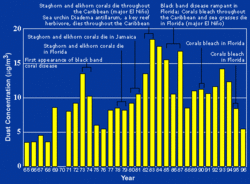Ocean pollution

Ocean pollution is pollution in the sea. It is a form of water pollution. "Ocean pollution" and "marine pollution" mean the same thing.
Ocean pollution
Marine pollution occurs when harmful effects result from the entry into the ocean of chemicals, particles, industrial, agricultural and residential waste, noise, or the spread of invasive organisms. Most sources of marine pollution are land based. The pollution often comes from nonpoint sources such as agricultural runoff, wind-blown debris and dust. Nutrient pollution, a form of water pollution, refers to contamination by excessive inputs of nutrients. It is a primary cause of eutrophication of surface waters, in which excess nutrients, usually nitrogen or phosphorus, stimulate algae growth.
Many potentially toxic chemicals adhere to tiny particles which are then taken up by plankton and benthos animals, most of which are either deposit or filter feeders. In this way, the toxins are concentrated upward within ocean food chains.
When pesticides are incorporated into the marine ecosystem, they quickly become absorbed into marine food webs. Once in the food webs, these pesticides can cause mutations, as well as diseases, which can be harmful to humans as well as the entire food web.
Toxic metals can also be introduced into marine food webs. These can cause a change to tissue matter, biochemistry, behaviour, reproduction, and suppress growth in marine life. Also, many animal feeds have a high fish meal or fish hydrolysate content. In this way, marine toxins can be transferred to land animals, and appear later in meat and dairy products.
Every time we wash a car or use fertilizer on our lawns we are polluting the ocean.[1] People often think that water pollution comes from big factories, but most of the pollution comes from everyday people doing everyday things. This kind of pollution is called nonpoint-source pollution because we cannot point out where it came from directly. All waste water, in time, enters a body of water (usually a stream). Every stream leads to a river, and every river leads to an ocean.
Oil spills
Because so many people use oil, large ships must take billions of barrels of it across the oceans. If it is not handled carefully, these trips can be very bad. In 1989, the United States experienced a large oil spill in Prince William Sound, a waterway on the Alaskan coast. The Exxon Valdez, a very big ship, hit a reef and spilled more than 260,000 barrels of oil.[1] The results were very bad. A great number of animals were covered in oil and began dying immediately. Animals that ate these oil-filled animals also died. Many Alaskans who lived by fishing these animals lost their businesses. Even though many animals were saved, and the Exxon Oil Company spent 2.5 billion dollars trying to clean up the oil, Alaska's wildlife still suffers.[1]
Ocean Pollution Media
Acid mine drainage in the Rio Tinto River
A graph linking atmospheric dust to various coral deaths across the Caribbean Sea and Florida.
One type of marine pollution: the breakdown of a plastic bottle in the ocean into smaller fragments, eventually ending up as micro- and nano-plastics
An island with a fringing reef in the Maldives. Coral reefs are dying around the world.
The effect of eutrophication on marine benthic life
References
- ↑ 1.0 1.1 1.2 Earth Science. 1120 South Capital of Texas Highway, Austin, Texas 78746-6487: Holt, Rinehart and Winston. 2001. ISBN 0-03-055667-8.
{{cite book}}: CS1 maint: location (link)








